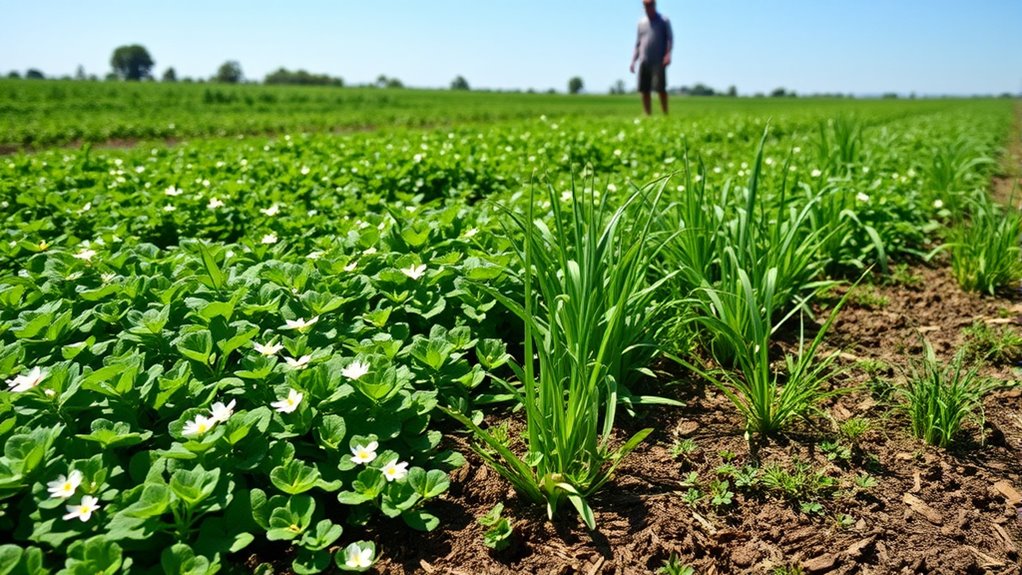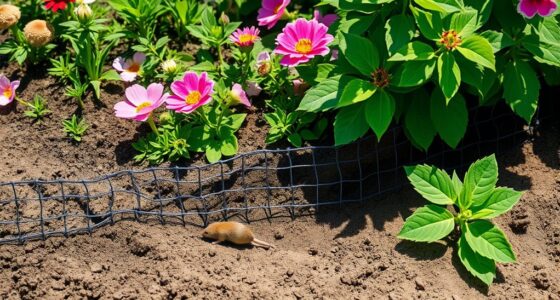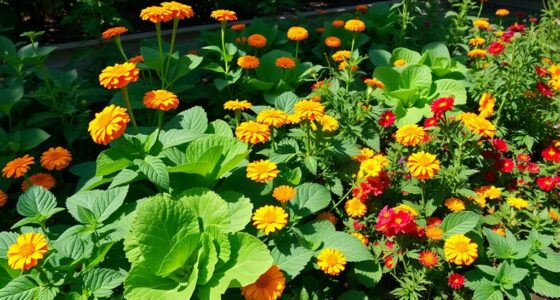Living mulches can boost your soil health, reduce weed growth, and conserve moisture, making your garden more sustainable. They also attract beneficial insects and support water efficiency, but can compete with your main crops for nutrients and water if not managed properly. Some mulches may harbor pests, so monitoring and careful species selection are key. To optimize benefits and minimize drawbacks, you’ll find helpful tips if you continue exploring this topic further.
Key Takeaways
- Living mulches improve soil health, suppress weeds, and conserve moisture, enhancing sustainability in agriculture and gardening.
- They can attract beneficial insects and pollinators, aiding pest control but may also harbor pests if unmanaged.
- Competition for nutrients and water from mulches may reduce crop yields if not carefully managed.
- Proper species selection and management practices help balance mulch benefits with crop needs.
- Regular monitoring and targeted pruning optimize living mulch performance and minimize potential trade-offs.

Living mulches are living plants grown between or around main crops to improve soil health, reduce weeds, and conserve moisture. When you choose to incorporate living mulches into your farming or gardening practices, you’re actively working to enhance soil conditions and create a more sustainable environment. One of the key benefits is their ability to help maintain soil moisture. These plants act as a cover, reducing evaporation and shielding the soil from harsh sunlight and wind, which can dehydrate your main crops. This means less frequent watering and better water efficiency, especially during dry spells. Additionally, living mulches can suppress weeds by competing for sunlight, nutrients, and space, which reduces the need for chemical herbicides and manual weeding.
Living mulches conserve moisture, reduce weeds, and improve soil health naturally.
However, integrating living mulches requires careful planning, as they can also influence pest management. Some living mulches attract beneficial insects that prey on pests, creating a natural pest control system. For instance, flowering ground covers can bring in pollinators and predatory insects, helping to keep pest populations in check. On the other hand, certain types of living mulches might host pests themselves or provide shelter for unwanted critters, potentially increasing pest pressure. You need to monitor your crop and mulch interaction closely, selecting plants that support beneficial insects while minimizing pest habitats. Proper management includes timely pruning, species selection, and understanding your local pest dynamics to prevent the mulch from becoming a pest reservoir.
Another trade-off to contemplate involves the competition for nutrients and water. While living mulches can improve soil structure and fertility over time, they also draw resources from your main crop, especially if they’re fast-growing or aggressive. You might find yourself needing to balance mulching benefits with the risk of your main crop experiencing nutrient deficiencies. To mitigate this, you can choose mulch species with complementary growth habits or implement targeted fertilization strategies. Keep in mind that the success of living mulches depends on your ability to manage their growth effectively and adapt to your specific crop requirements. Furthermore, selecting appropriate mulch species that are compatible with your crops can help optimize benefits and reduce potential issues.
In essence, living mulches offer a promising way to boost soil health, conserve moisture, and support pest management naturally. But they also demand attentive management to avoid unwanted competition or pest issues. When you carefully select the right species and monitor their interactions with your crops, you create a more resilient and sustainable farming system. The key lies in understanding the delicate balance between benefits and trade-offs, and adjusting your practices accordingly to maximize the advantages of living mulches.
Frequently Asked Questions
How Do Living Mulches Affect Soil Nutrient Levels?
Living mulches improve soil nutrient levels by boosting soil microbial activity, which helps break down organic matter and release nutrients for plants. They also reduce nutrient leaching by protecting the soil surface and maintaining moisture. However, if not managed properly, living mulches can compete with main crops for nutrients, potentially depleting soil nutrients over time. Proper management guarantees they enhance, rather than hinder, soil fertility.
What Are the Best Plant Species for Living Mulches?
You should choose plant species with high shade tolerance and diverse root systems for living mulches. Clover, creeping thyme, and sweet woodruff are excellent options because they thrive in shaded areas and promote soil health. These plants establish strong, varied root systems that prevent erosion and improve nutrient cycling. Select species suited to your climate and soil conditions for ideal benefits, ensuring your living mulch remains effective and sustainable.
How Do Living Mulches Impact Water Conservation?
Living mulches help you conserve water by increasing water retention in the soil, which reduces the need for frequent watering. They also cut down on runoff, allowing more water to soak in rather than wash away. This means your plants stay hydrated longer, and you use water more efficiently. By choosing the right living mulches, you can make your garden more sustainable and resilient while saving water and reducing waste.
Can Living Mulches Be Used in Organic Farming?
Yes, you can use living mulches in organic farming. Focus on selecting cover crops suited to your soil and climate, like clover or vetch, to enhance benefits. Use mulch integration techniques such as planting between rows or under the main crop to suppress weeds, conserve moisture, and improve soil health. These practices align well with organic principles, making living mulches a sustainable choice for your farm.
What Are Common Pests Associated With Living Mulches?
Imagine your garden as a bustling city, where living mulches act like vibrant neighborhoods. They attract insects, sometimes leading to pests like aphids, beetles, and slugs. These pests are drawn by the lush cover, but healthy pest suppression methods, like encouraging natural predators, help control them. Keep a close eye on insect attraction to prevent infestations, ensuring your living mulch benefits outweigh potential pest issues.
Conclusion
While living mulches offer many benefits like weed suppression and soil health, some worry they might compete with crops for nutrients. However, with proper management, you can balance their growth, ensuring both plants thrive. The key is selecting the right species and timing their establishment. Embracing living mulches not only boosts sustainability but also reduces your reliance on chemical inputs, making your farm more resilient. Don’t let concerns hold you back—start small and see the benefits unfold.









